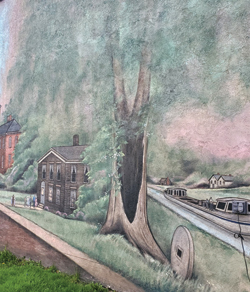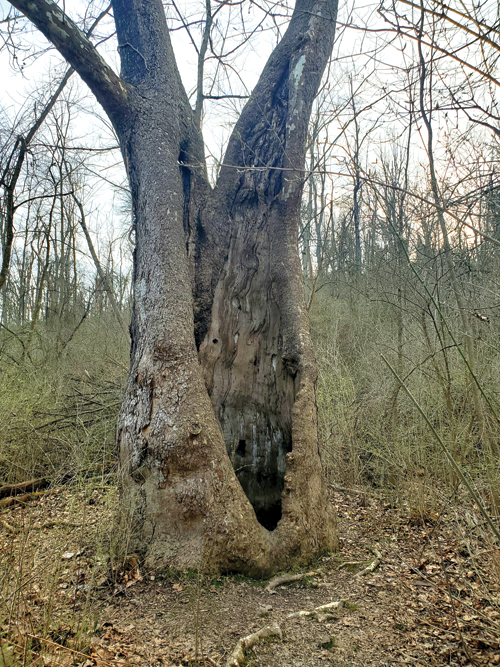350-year-old Independence tree stands test of time
by Laura Bednar
The city of Independence boasts many historical buildings and connections to past events, but a lesser-known landmark has grown in the city’s backyard for centuries.
A sycamore tree in the Cuyahoga Valley National Park has lived for an estimated four centuries according to the report “The Tree with Many Names” by CVNP volunteer Becky MacKay and biologist Ryan Trimbath.
The tree is located along the Riverview Road extension, which is no longer open for traffic and chained off at the entrance. According to Independence historian Wes Gaab, the tree is roughly half a mile down the road and easily spotted.
The tree was last measured at 82 inches in diameter, close to 100 feet in height, and hollow, allowing a full-grown adult to stand inside it, some without touching the inner walls. Gaab has held over 50 historical tours of landmarks in the city, and the tree was a popular attraction.
In his younger days, he said he would jump down inside the tree to exemplify its size to the tourists.
While hollow, the tree is sustained as a six-inch thick rim, which Gaab said is where the water and nutrients run. As a former biology teacher, he added that the roots likely extend anywhere from 50 to 70 feet from the tree base, allowing easy access to water.
It was during the U.S. Bicentennial in 1976 that a committee searched for trees that were still standing after living through the American Revolution, according to MacKay and Trimbath’s report. The Sycamore tree was estimated to be around 300 years old at that time, and was only one of 10 trees in Northern Ohio that qualified for the distinction of U.S. Bicentennial Tree.
“That’s how it got its popularity renewed,” said Gaab.
It’s history, however, starts much further back with a variety of names for the leafy giant.
Many monikers
Native Americans were said to have used the tree for shelter and to meet with other tribes to smoke a pipe of peace during hunting season, according to the report. This earned it the names of “Peace Tree,” and “Council Tree.” In the late 1700s, Moravian missionaries and Native American converts established a town known as Pilgerruh or “Pilgrim’s Rest” in German. While the report states the location of the town is debated, any of the proposed locations put it within a mile and a half of the tree, which has also been called “The Pilgrim’s Sycamore” and “Moravian Sycamore.”
Before the national park was established, the tree was on John Geissendorfer’s farm in Independence Township. Gaab said there were two farms near the tree, Geiseendorfer and Walker, which are no longer in operation. When they were working farms, Gaab said the land had good soil but the location made it difficult for the farms to continue.
The report noted that a Plain Dealer article from 1946 reported the Western Reserve Chapter of the Daughters of the American Revolution had placed a sign in front of the tree, which confirmed the tree sheltered Moravian missionaries in 1786 and the people disembarked from their canoes on the Cuyahoga River to establish the town.
In what is estimated to be sometime in the 1940s, according to the report, highway workers used dynamite to blow off the top of the tree because large branches hanging over the road were considered dangerous to traffic. This blast led to the tree’s other classification, “Die Hard Tree” because it continued to grow.
In 1946, to commemorate the 150th anniversary of the city of Cleveland’s founding, a commission searched for native trees that were part of the forest when founder Moses Cleaveland landed at the mouth of the Cuyahoga River in 1796. The report stated that the public nominated trees for the distinction and the diameter at breast height was measured to judge if the tree was at least 150 years old. The Sycamore was then named one of 150 trees to be a “Moses Cleaveland Tree.”
The civic organization Early Settlers Association of the Western Reserve was attempting to map Moses Cleaveland trees in Ohio in 2020. More information can be found at earlysettlers.org.
A less historical name for the Sycamore was the “Lover’s Tree.” As Gaab explained, the road alongside which the tree grows is not maintained and closed to vehicles, which made it a romantic spot to go for a walk with your sweetheart some years ago.
The tree remains standing today but without any identifying labels or plaques. Gaab said it might be the oldest living landmark in the city.
“I like to believe it will keep living,” he said. “If it can live at least 350 years, who’s to say it can’t live more?” ∞

mural on the side of the former C&B Garage building on Brecksville Road. Photo by Laura Bednar.

in Independence for over 350 years, surviving even a dynamite
blast. The tree stands at about 100 feet tall and the photo looking
upwards was taken standing within the hollow tree.
